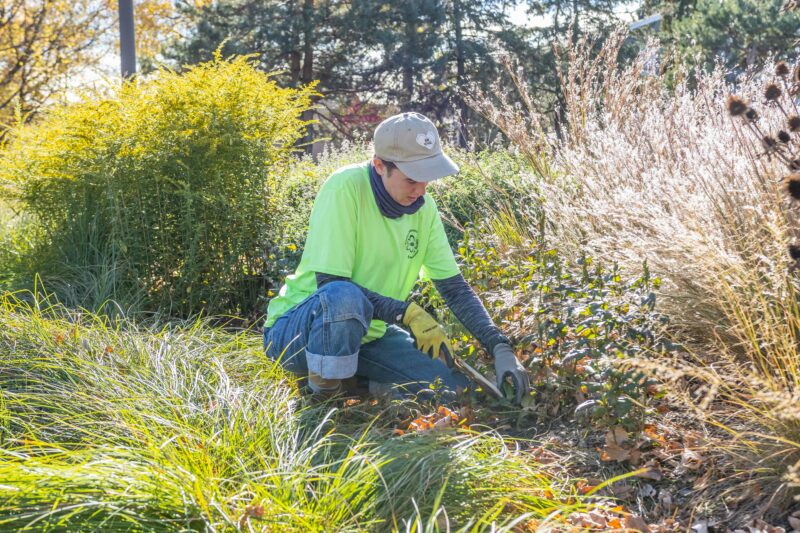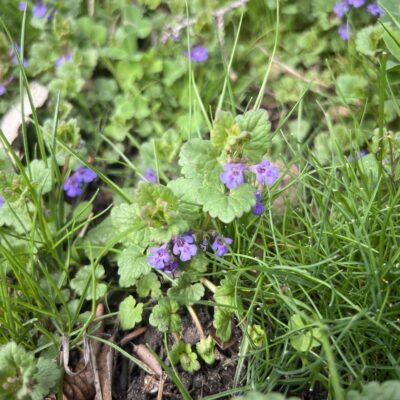
The growing season is finally here! Spring brings the excitement of seeing perennials return to our gardens. Soon, native plants will be busy providing resources for wildlife, sequestering carbon, and continuing to filter stormwater runoff with their roots.
But with new growth comes new weeds. Weeding is an inevitable part of maintaining a native pollinator garden, especially in its first three years while plants are establishing. In this blog post, we’ll dig into what it really means for a weed to be a weed and cover some tips for identifying and managing common weeds in Minnesota yards.
What is a weed?
Weeds are simply plants that are out of place. They are not inherently good or bad. Which plants we consider weeds changes with information, context, and opinion. While some plants can be aggressive, many can coexist with desired species without outcompeting them.
Weeds can even have helpful aspects. They can slow erosion, improve soil health through their quick-growing roots, and can be used as food or medicine for people. Much knowledge on medicinal and edible uses of plants we consider weeds comes from Indigenous people, including the Dakota and Anishinaabe peoples on whose homeland we live. Wakan Tipi Awanyankapi’s seasonal webinar series Gifts of the Plant Nation is a great resource for learning about Indigenous relationships with native plants.
Even when considering a single plant species, it’s not always black and white. For example, Canada Goldenrod (Solidago canadensis) is native to areas of Minnesota and is a great food source for native bees and butterflies. However, it spreads rapidly and can quickly overwhelm your yard or rain garden. By the way, its pollen grains are too large to be a source of human allergy symptoms! You can blame ragweed for that.

Another example is ground ivy, commonly known as creeping Charlie. Ground ivy is a non-native flowering species that overtakes lawns. Its flowers do provide food for a range of native insects, but it has a much lower nutritional value compared to the nectar and pollen of native plants. True, ground ivy provides more benefit to pollinators than a lawn solely composed of Kentucky bluegrass. But replacing it with low-growing native alternatives like hepatica, wild ginger, or geranium is a better choice for ecosystem health.
Weeds become problematic when they take over and prevent native plants from thriving. Some weeds are even toxic to animals or humans. These weeds must be managed to protect the purpose of a planting, such as providing pollination services or capturing stormwater.
Managing weeds
Weed management starts with prevention. Planting densely, incorporating edging, and adding 2-4 inches of mulch to a new pollinator planting all help with weed control. For edging, select a material that you can insert a few inches into the ground, such as old bricks.
Still, weeds will inevitably show up in your planting. This is not a sign of failure! Weeds appear for many reasons, many outside of our control. Weed seeds can blow into gardens from neighboring areas and be transported by animals. Weed seeds accumulated in the soil can germinate when exposed during the garden prep process. With patience and persistence, weeding demands will lessen as your native garden matures. Once established, native plants will naturally suppress most weed growth. Here’s some weeding tips for a pollinator garden in its first few years:
Weed a newly planted pollinator garden at least three times throughout the growing season, weekly if possible.
It’s easier to hand pull small weeds frequently rather than waiting until they become unwieldy. At the very least, weed your garden three times a year: around Memorial Day (late May), Independence Day (early July), and Labor Day (early September).
Cool-season weeds like ground ivy, lambsquarters, and quackgrass start to sprout and spread by late May. Pull these quickly before they start going to seed and accelerating their spread. Warm-season weeds like burdock, crabgrass, stinging nettle, and thistles are emerging now, and volunteer trees, like ash and buckthorn, start emerging in mid-June. Try to pull these before July 4th.
For a small garden, weeding just a half-hour a week can make a big difference! Weeding doesn’t have to be drudgery—enjoy the sensation of the soil, the sights and scents of your garden, or the excuse to spend quality time with a loved one.

Get to know your plants.
It can be hard to tell apart weeds from intentionally planted native plants, especially in earlier stages of growth. Making a planting template that shows which plants were planted in your garden and where, as well as details like appearance and bloom time, can help you pick out desired plants from weedy plants during maintenance. You can also use popsicle sticks to label your plants. Apps like Google Lens, iNaturalist, or PictureThis can also help with weed identification. (Check out our Identifying Native Plants blog post for more tips!)
Follow weeding best practices.
When hand-pulling weeds, try to remove as much of the plant as you can, including seed heads, berries, and roots. Grab the weed close to the ground and pull straight up. Weeding after a rain event or watering the ground makes it easier to remove weeds. Tools like dirt knives and trowels can also be helpful! Use herbicides only as a last resort, in small amounts, and only if you have been trained in safe use of chemicals. Improper application can kill desirable plants and harm animals and people and pollute our waters.
After removing a weed, fill in the hole and cover bare soil left behind with mulch to prevent new weeds. Do your best to minimize damaging your desirable native plants. You’ll also want to properly dispose of your weeds. Weeds left on the ground can spread seeds or re-root. Most weeds can go in your yard waste. Do some research first—weeds on the MN Department of Agriculture’s Noxious Weeds List have different requirements.
Accept imperfection.
Some weeds, like non-native creeping bellflower, have deep taproots and horizontal rhizomes that make manual removal difficult, but not impossible. Weed removal is a continual and multi-year process. Complete eradication doesn’t have to be your goal. Consider ways of engaging with your weeds positively, like turning them into compost for your garden or trying culinary experiments with edible weeds. You may start to appreciate their beauty, or daresay, learn to love them, even as you work to remove them. After all, they are plants, too, doing their best to survive and thrive.
For more on weed identification, removal, and uses, check out our All About Weeds Zine!
– Megan Reich, Metro Blooms Communications and Program Manager
